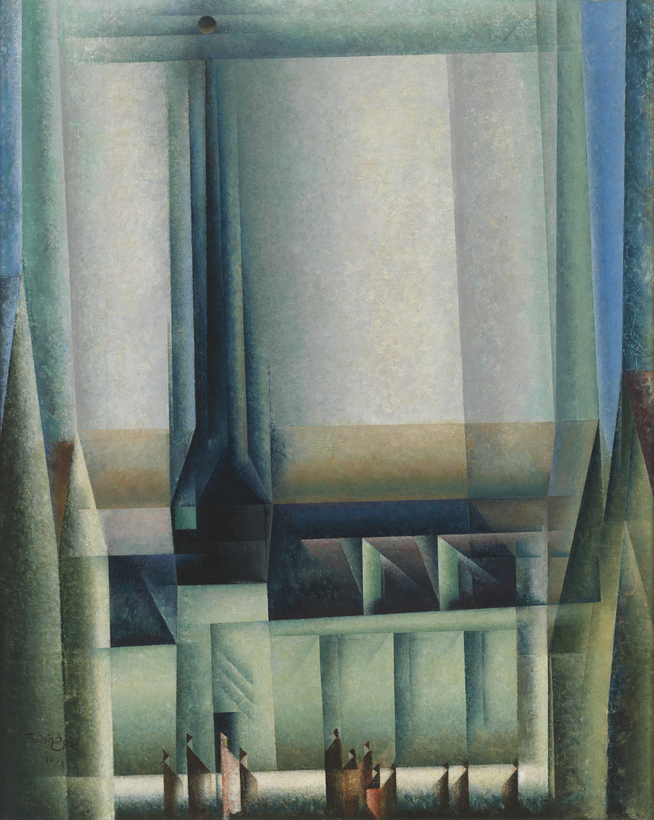The events are generally described the same way. On January 30, 1933, Adolf Hitler was appointed chancellor of Germany and the Third Reich assumed power. In April, the Gestapo padlocked the doors of the Bauhaus school, in Berlin, a renowned institution for art and design. Having closed the Bauhaus, the propaganda minister of the Reich said it could reopen if it embraced a nationalistic style. The faculty members refused, and the school’s doors never opened again. Some of the Bauhaus geniuses had already fled to other countries; many of the rest now followed. There was no other version of the history. End of story.
At the Bauhaus, during the 14 years it existed, human creativity reached an apogee that inspired comparisons to the Italian Renaissance. Thanks to such lights as Josef and Anni Albers, Marcel Breuer, Walter Gropius, Wassily Kandinsky, Paul Klee, and Ludwig Mies van der Rohe, the art of painting entered new territory, and the look of household objects took a bold step into an unprecedented realm of simplicity and functionality. Armchairs and side tables became objects of Platonic beauty. Architecture was freed of clutter. Graphic design, textile-making, metalwork, glasswork, theater sets—all that was visible became clear and luminous as never before. Even doorknobs had a freshness that put joy in the air.

Now, in the city of Weimar, where the Bauhaus was founded in 1919, “Bauhaus and National Socialism” has just opened. Spread across the Bauhaus Museum Weimar, the Museum Neues Weimar, and the Schiller Museum, the exhibition invites a fresh look at what actually happened after the curtain came down. Though people prefer to think otherwise, the closing of the Bauhaus was not a full stop.
To begin with, many Bauhauslers hung on during Germany’s reign of terror. A former Bauhaus student, the architect Franz Ehrlich, incorporated his design sense into the sign over the entrance to Buchenwald—even though he was incarcerated there. Another Bauhaus student assisted with the architecture of Auschwitz, and would escape sentencing at the Nuremberg trials because his blueprints labeled the infamous gas chambers as “shower rooms.” The journalist Morley Safer once told me that some elements of Bauhaus style, in fact, suited the Nazi mentality.
Text on the three-part show, which was organized by the cultural institution Klassik Stiftung Weimar, states its premise clearly: “Even today, the Bauhaus is considered by many to be the antithesis of National Socialism. However, modernism of the early 20th century was by no means immune to the seductive ideology of the Nazis.” The exhibition curator Anke Blümm explains that “the show reveals a range of contradictions: many Bauhaus members that the regime derided as ‘degenerate’ were still able to build successful careers under the Nazis.” For instance, at the Schiller Museum, one finds a family baby cradle of oaken swastikas, designed by Ehrlich for the Buchenwald camp commandant Karl Otto Koch.

Of the 1,400 members of the Bauhaus, approximately 900 remained in Nazi Germany after the school closed. Many of them left subsequently, and 24 were murdered, but others continued to do their work in cooperation with the Reich. We learn from the show that “more than a dozen former members of the Bauhaus participated in the exhibition ‘German People–German Labour’ of 1934, including Walter Gropius, Ludwig Mies van der Rohe, Herbert Bayer and Lilly Reich.” Still, Gropius, Mies, and Bayer soon sought refuge in the United States.
We should not forget, however, what the German chancellor Helmut Kohl said in 1983, at the opening of the Josef Albers Museum, in the artist’s hometown of Bottrop, Germany. The dynamic world leader reminded the audience that the evils of Nazism had, 50 years earlier, deprived the country of many of its greatest geniuses and robbed them of the chance to work in what had been idyllic conditions. The artists who went to the Bauhaus did so in search of artistic freedom, and once that freedom gave way to tyranny, most of them not only needed, but wanted, to leave their homeland forever.
“Bauhaus and National Socialism” will be on in Weimar, Germany, until September 15
Nicholas Fox Weber is the executive director of the Josef & Anni Albers Foundation and the author of 15 books, including Le Corbusier: A Life. His biography of Mondrian will be published this October


